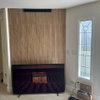will arc fault breakers often trip when using a vacuum cleaner?
consed
12 months ago
Featured Answer
Comments (7)
HU-867564120
12 months agolast modified: 12 months agoSeabornman
12 months agoRelated Discussions
circuit breaker tripping frequently
Comments (17)Hire an electrician. Just realize how much you are struggling to solve the problem and how important it is to fix the problem. Not just for your peace of mind and convenience, but in case of any safety risk there may be with the current condition. Now when he comes in to fix the proplem and presents you with the invoice, remember how difficult it is to diagnose the problem and how important it is for it to be fixed. I have had customers say "I have had my uncle and cousin over here for 2 days tearing things apart to find the problem with no success." I walk in, diagnose the problem, make the necessary repairs and present them with an invoice. Then, here it comes, "why is it so much? You were only here less than an hour." All of a sudden I made it look easy and not worth paying me my service call rate. I am not shy about saying " You are paying for the 20+ years of knowledge and experience, a truck full of tools and meters, insurance, license and all the other things that made it possible for me to come here to help you today. It is not just about the hour it took to fix the problem."...See MoreRemove the arc-fault breaker?
Comments (16)Sorry but I have to disagree with TerribleTom and I may be talking out of school and he/she may be correct in terms of what a licensed electrician does in terms of insurance etc but licensed or not, I would imagine if they do something that is not up to code, it doesn't matter if the sparky is licensed or not, I wouldn't think. Show me a single example of a court ruling in favor of an insurance company because the insurance contract states that any fire resulting from something not up to code is not covered. If you can find one, I'll reconsider my position. But you won't find one. Why? Because mortgage lenders wouldn't accept it as valid coverage to protect their interests. Insurance companies may try to wriggle out of paying in some cases and play some games now and then, but the underlying principle is whether or not the covered parties (typically the homeowner and the mortgagee or trustee) were negligent. Even in cases where insurance companies have attempted to put explicit language in insurance contracts shifting the burden to the insured to maintain everything in up-to-code status, they've lost good-faith insurance lawsuits right and left. It's not the kind of conditions that courts are inclined to enforce via adhesion. Period. [As a side note, pjb999, I said nothing in my comment about licensure status of the electrician. Please re-read carefully. You invented that part.] For the most part, a homeowner needs only to act as a reasonably prudent person to keep coverage in effect. Hiring an electrican (even if, unbeknownst to the homeowner, the electrician is not, in fact, licensed) is still reasonable behavior, as is following the advice of someone reasonably believed to be qualified and knowledgeable. I've heard insurance scare stuff for years. Give me true examples. Give me the case law. I really want to see it. As for the Katrina stuff, well force majeure (acts of God) is another issue altogether. But, again, even in the context of a Katrina victim, show me a case or even a documented annecdotal example where a claim was denied solely on the basis of wiring not being up to code. Go for it. As for the safety part of your comment, please refer to my first comment in this thread: While it may be tempting to blame a circuit breaker when it trips, most of the time breakers are correctly doing the job they were intended to perform--to keep you and your house safe from fire. On that, we agree....See MoreA/C circuit board fried- could the house wiring be at fault?
Comments (17)Holly, You gave incomplete information in your initial post which lead me to believe it was the furnace circuit board that was having the trouble. A carrier infinity system has different levels and different configuration of those levels. You posted back with only the model number of the outdoor unit, which is a variable speed infinity condenser with variable speed compressor. So with this type of unit you have circuit boards in the outdoor condenser to control the AC / DC inverter of the condensing unit and on the furnace you would also have a circuit board that controls the AC/DC inverter of the variable speed blower / or ECM motor. It's very rare for the furnace circuit board to fail on either a full variable speed motor or ECM type motor. Nearly always the motor itself fails. The circuit board for the outdoor unit has 2 heavy loads tied to it, number 1 the compressor, number 2 the condenser fan. The inverter for your outside condenser will generate heat ---a lot of heat. The hotter it is outside, the dirtier it gets the hotter it gets until something fails. In an inverter condenser this is most often the board. I can only assume at this point that it was the circuit board in the outdoor condenser that failed. Which if this is the case would make perfect sense. Other things (besides heat) that can effect electrical components: Loose connections. Electricity will take the path of least resistance. A loose connection is often the tightest when the unit is off. When the unit runs, current flows. There is heat in current. Given a loose connection the heat during operation is hotter than when the apparatus is off this gives expansion and contraction of that loose connection which leads to erratic operation. The expansion occurs while the unit runs, the current flow drops due to the electrical path being disrupted which will give you the feeling of 'brown out' activity. When in fact, it's merely poor wiring. ------------ LED Lighting: Some of this kind of lighting is very finicky in how it needs to be installed. Putting on dimmer switches can cause flickering and possibly even the glow you talk about. Certain LED manufacture's make lighting in which there are no changeable light bulbs. When the light fails you have to replace the entire fixture. Part of the reason for these types of fixtures is that LED bulbs can last a really long time. But manufacture's often stretch the truth in these circumstances as in they will tell you it will last 18 years when more often than not it's 5 or less years. It's still a long time compared to the older incandescent bulbs and a bit longer than the newer flourescent bulbs. An LED bulb doesn't require 120v to operate, where as the older incandescent needed 120v same as flourescent bulb. You have to understand this because the LED bulb itself often isn't what fails. It's the mechanism they use inside the bulb housing they use to drop the voltage from 120v to whatever the voltage requirements are for the LED bulb being used. This is why you have certain LED configurations that will run low volt lighting off a transformer to operate an LED lighting system. You can have mood lighting / every color of the rainbow / different colors for different rooms and so on. However, these kinds of lighting systems are very complex in how they operate and the joke: How many people does it take to change a light bulb? Is taken to new heights. These things are often sold to the home owner under the guise of being a smart home....See MoreNew house help: bad electrical install, too many things on one breaker
Comments (17)Ditto what Ron said about the situation: What's code here and what's a best practice are two different things. I don't think that the bar should be set at "what's code" in this situation. You will have to push your GC, but the standard here should be "what's serviceable" above and beyond "what's code". If GFCI nuisance tripping is shutting down your office, that may not be a code violation, but it shouldn't fly. Outside outlets have to be protected by a GFCI. Nuisance tripping of an outdoor GFCI is an easily foreseeable issue. Your office outlets should not be down stream of that (best practice). Do as suggested and make each outdoor outlet a GFCI (and don't connect anything on the "Load" side). That way one tripped GFCI doesn't take out all of the outlets AND you know which one caused the problem. Your laser printer can use large amounts of current when it starts printing. Using 8-12 amps isn't uncommon - primarily because of the fuser. Code requires that circuits be designed so that permanently attached loads not exceed 80% of the rated capacity of the circuit. A well designed residential electrical system takes into account likely uses for non-permanently attached loads (things plugged into outlets) and gives plenty of extra capacity (best practice). Things like a hair dryer / curling iron in a bedroom, a space heater in a room with lots of glass, electric lawn mower / hedge trimmers or holiday lights outside are all very easy to anticipate. So is electronics / laser printer / AV gear in an office or spare bedroom. Any one of these loads could put you near 60-80% of a 20 amp circuit all by themselves. I'm an advanced DIY - but when I do residential electrical work all general outlet circuits are 20 amp (code allows 15 amp). Circuits used for outlets are limited to one just one room (Bedroom 1 outlets, Bedroom 2 outlets, Living Room outlets, etc.). Some large rooms get will get more than one circuit. Outlets in a hall may be on a circuit with the nearby room. Outside outlets get at least 2 circuits - again for decor / power tools. These are my general guidelines. Some rooms (Kitchen, bath, for example) the minimum circuits are proscribed by code....See Moremtvhike
12 months agosnappity
12 months agolast modified: 12 months agosnappity
12 months agoLette nyano
7 months agolast modified: 6 months ago
Related Stories

KITCHEN STORAGEShould You Use Open Shelves in the Kitchen?
Two designers make their cases for and against using floating kitchen shelves
Full Story
FLOORSWhat to Ask When Considering Heated Floors
These questions can help you decide if radiant floor heating is right for you — and what your options are
Full Story
HOUSEKEEPINGWhen You Need Real Housekeeping Help
Which is scarier, Lifetime's 'Devious Maids' show or that area behind the toilet? If the toilet wins, you'll need these tips
Full Story
FEEL-GOOD HOME12 Very Useful Things I've Learned From Designers
These simple ideas can make life at home more efficient and enjoyable
Full Story
SELLING YOUR HOUSEFix It or Not? What to Know When Prepping Your Home for Sale
Find out whether a repair is worth making before you put your house on the market
Full Story
DECORATING GUIDESDesign Debate: Should You Use Books for Decoration?
Color blocking, books by the yard, blank covers — is all fair in love and decor?
Full Story
KITCHEN DESIGNYes, You Can Use Brick in the Kitchen
Quell your fears of cooking splashes, cleaning nightmares and dust with these tips from the pros
Full Story
ORGANIZINGDecluttering and Organizing When Your Family Is Not on Board
A professional organizer shares how to work toward a tidy home as the sole enthusiast in your home
Full Story
LIFEWhen Your Tastes Clash: How to Design and Decorate as a Couple
Want to keep the peace? Work with both of your styles when remodeling, decorating or building new, for a home that feels right to all
Full Story
LIGHTING8 Ways to Use Plug-In Sconces in Your Lighting Scheme
Plug-in, wall-mounted sconces help unclutter desks, add visual interest and more. See if they are right for you
Full Story





consedOriginal Author